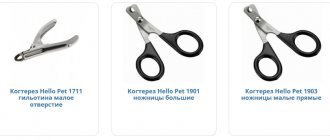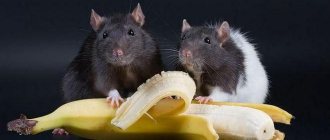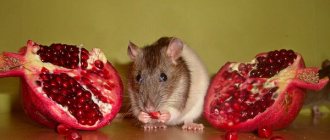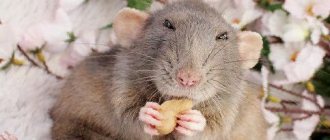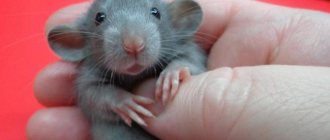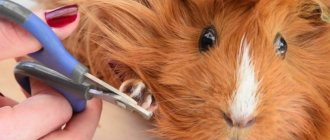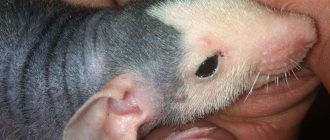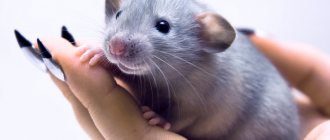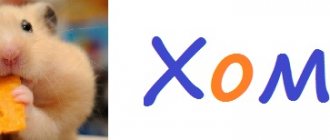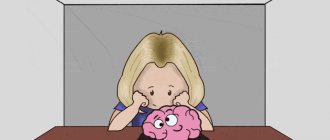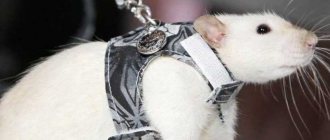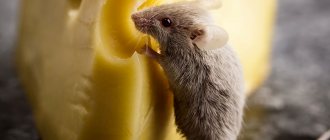It is not necessary to trim your rats' claws, and you can try other methods to shorten your animal's claws. Trimming rat nails can be stressful and difficult. Because rats are small and difficult to keep in place, it can be quite difficult to carry out the procedure correctly. In this article, we will try to answer basic questions about trimming rats' claws.
Is it possible to trim a rat's claws?
Yes, you can trim rats' claws, but the rodent can feel good without this procedure. Healthy rats will take care of their own claws. They wear them down naturally by running, and also chew off the ends with their teeth if they deem it necessary. Some rats are good at grooming themselves and others are not, but healthy rats rarely have problems with nail length. If the animal does not scratch itself constantly, you can leave the nails as they are without trimming them. So, from a grooming perspective, rats do not need to have their nails trimmed if they are active and healthy.
However, this procedure can be carried out if necessary. Unlike cats, rats do not retract their claws and use them to climb. This may cause scratches on a person's bare skin.
Poodle haircuts: shapes and types
The poodle's coat encourages experimentation. There are many interesting models for this breed. A simple hygienic haircut will suit your pet. And show dogs require special shapes.
Important! Choosing a hairstyle for your pet should also take into account the time of year.
Haircut "Scandinavian Lion"
It’s not difficult to guess from the name; a poodle trimmed in this way resembles a lion. The hair on the head has a direct transition along the neck, the eyes remain open.
All hairs on the face are completely removed. But boys can keep short mustaches.
The coat is even on the ears and remains long along the body, except for the butt and hips. Balls or pom-poms are made of wool on the limbs and tail.
Haircut "Modern"
The limbs, muzzle, throat and foretail are completely shaved. In other places the cover is shortened. According to the norm, it should not be longer than a centimeter.
There are variations of this hairstyle, so the groomer must be well versed in it. Improper execution will be grounds for disqualification.
Anglo-Saxon haircut
Looks like a lion's hairstyle. The general shape is cut according to the principle of a lion. However, on the back, lower back and groin, the hair is kept up to 1 cm long. A ball is made on the tail.
The entire muzzle and neck are shaved. It is permissible to trim the “cuffs” on the hind legs.
Korean haircut
A poodle clipped in this way is like a lamb. The fur on the body and limbs is cut to two and a half centimeters.
The length on the head can be longer, the main thing is that the dog is similar to a children's toy.
Hygienic haircut
When the pet has not been groomed for a long time, this haircut is performed. The coat is completely shaved to rid the poodle of tangles and tangles. This is done when nothing can be combed out or fixed in any other way.
Another case is trimming a haircut. The groomer simply evens out the coat, making the poodle more neat.
Important! If injuries are found during the cutting process, they should be treated immediately. If necessary, contact a veterinarian
Haircut "Continental"
This is a show haircut. The head, body and paws are cut according to the “lion” principle. The difference is the formation of two balls of fur on the poodle's body.
Japanese haircut
She's "Asian". The main task is to turn an uncut poodle into a “toy”. Girls have their hair braided, beads, bows and other decorations are hung.
An important difference from all previous styles: the master cuts the dog’s hair based on its character. Delicate pets are given appropriate shapes. Geometry is given to more menacing dogs
Geometry is given to more menacing dogs.
Haircut "Lion Mapogo"
All fur is cut to the same length. The coat is maintained throughout the dog. Exception: the ball at the tip of the tail.
Haircut "English saddle"
The muzzle, forelimbs and tail are trimmed. The hind legs retain fluffy hair. The joint area is shaved down to the skin. The tail is made the most magnificent and round.
Kennel haircut
The most practical. The hair is the same length as a poodle clipper. The limbs are shaped with scissors. The tail, muzzle and ears remain fluffy. In the finale, everything is modeled by a machine for smooth transitions.
Lamb haircut
Similar to the previous hairstyle, but only the muzzle hair is cut short. Another difference is that the coat is much shorter than in the Kennel cut.
Dutch haircut
Difficult even for salon execution. Effective only on royal varieties. Owners of toy poodles should avoid this hairstyle. Lush hair without pompoms is formed on the limbs. The beginning of the tail is shaved completely to make another large pom-pom at the tip. In the middle of the body, the hair is shaved to zero.
Bikini haircut
The muzzle is cut short. The paws are shaved, but the bottom can be formed into balls. The foretail is trimmed, and a lush oval is made at the tip. The chest is also completely shaved.
"Puppy" haircut
Performed for show poodles. The muzzle is shaved. The head and ears are lightly trimmed and combed for volume. The body is straightened. The paws are cut so that there is more fur at the bottom. The beginning of the tail is shaved.
When should you trim your rat's claws?
Trimming rat claws is not necessary. Rats usually take care of their own claws, cutting off the ends with their teeth if necessary. Rats will also wear down their claws naturally from running around. However, some people prefer their rats' nails to be short and blunt.
The main reason people trim rats' claws is because they don't like the scratches they make on the skin as they climb on top of their owners. However, there are cases when nail trimming is necessary:
- old age of the animal;
- aggressive behavior of the rat;
- the presence of skin parasites in the pet;
- the presence of diseases that cause degeneration of the hind legs.
Often the procedure is necessary when the rat is no longer able to use its hind legs and the claws cannot be worn down on their own. In other cases, rats may have skin parasites, and trimming their nails will prevent damage to the owner's skin if the pet likes to crawl on a person's body.
Nail trimming becomes especially important if rats become extremely itchy, such as when they have external parasites. In these cases, trimming, especially the back nails, will help them avoid hurting themselves by severe scratching.
If the rats are old, it is important to trim their nails. As rats get older, they are unable to reach their back legs, making it difficult for them to trim their own claws if they need to. Also, if they have degeneration of the hind legs, the animals are not able to naturally break off their claws while moving, which causes the risk of overgrown claws.
Trim the nail a little higher quickly (red vein)
Find the quick inside of the nail and with your free hand, trim the nail just above the vein. If this is your first time trimming your pet rat's nails, you may want to give yourself more freedom and get away even more. Once you and your rat get used to the nail trimming process, it will become less stressful and much easier to do. Until you feel comfortable that you can cut close to fast, stay away. Instead, you can trim your rat's nails more frequently to keep them trim, such as three to four times a month (as opposed to once or twice). Repeating the process will only help you and your rat get used to nail trimming!
What does it take to trim a rat's nails?
To carry out the procedure you will need:
- pet clippers or children's nail scissors;
- towel;
- styptic powder or flour, corn starch.
Children's nail clippers can be used for trimming nails. They can be used on small animals, but can be inconvenient. The best pet claw clippers for rats are available in different sizes and look like short scissors with a notch in the blade.
It is much easier to see what you are doing when you have a dark surface behind the rats' body while trimming their nails. You can achieve this by wearing a pair of black or dark trousers and trimming the rats' nails while they are lying on your lap.
Having cornstarch, white flour, or styptic powder nearby will be helpful in case you accidentally injure a claw. You can stop bleeding by dipping the claw in cornstarch, white flour, or styptic powder.
Make sure the animal cannot move and seek help if necessary. It is often easiest to wrap squirming animals in a towel and simply remove one paw at a time.
Types of cars
A novice dog breeder who has decided to master grooming a pet on his own is intimidated by the abundance of models of clippers presented on the Russian market. Types of trimmers are divided:
- according to the method of operation and power supply of the machine;
- by type of engine;
- by power;
- weight and material of the case;
- knife material;
- number of nozzles;
- popularity of the manufacturer.
According to the method of operation and power supply of the machine
According to the method of operation and the principle of powering the engine, trimmers are divided into:
- mechanical (basic) - work from hand strength;
- electric (professional) – work from the network;
- rechargeable (wireless) – powered by rechargeable batteries;
- hybrid (combination of mains power and battery power).
Electric cars have different motors, depending on which they got their name:
By power
The power of the machine is an important indicator. Different power is needed for different types of fur (the coarser, the more powerful the device is needed) and the time of working with the animal (if you need to trim a large surface area or trim many dogs):
- low power (8–20) W;
- medium (20-35 W);
- powerful (up to 200 W).
The power of the machine is also determined by the number of revolutions of the knives; the higher this number, the more powerful the trimmer. The minimum speed is 2400 rpm, the average is 3500 - 45000 rpm, and the maximum is over 6000 rpm.
By weight and body material
To groom an animal, a person has to hold the clipper suspended all the time. Therefore, manufacturers have to look for a middle ground between weight and strength. According to materials, trimmers are distinguished from:
- cheap plastic;
- high-strength plastic;
- light metals such as aluminum, titanium and alloys;
- new generation composites;
- rubberized.
By weight, the following dimensions are often found:
- light (60 - 75 g);
- medium (100 - 200 g);
- heavy (200 - 600 g).
According to knife material
The development of industry has helped to find the best options for knives for grooming animals, which are distinguished by durability, duration of blade sharpening and coating to prevent overheating. On sale you can find machines with knives:
- made of high-strength steel;
- made of stainless steel;
- made of titanium;
- made of ceramics;
- from ceramic titanium.
Also, the ceramic, titanium and diamond coating prevents the knife from overheating so that the blade does not burn the skin of the animal.
By number of nozzles
Many trimmers come complete with several attachments (the most common sizes are 3, 6, 9, 12 mm), but they also sell individual attachments and entire professional sets. With their help, you can cut fur lengths from 0.05 mm to 32 mm.
The trimmer comes standard with 4 removable comb attachments. The best ones are metal ones; plastic ones grip wool worse and deteriorate faster. Many owners who groom their pets themselves are faced with the fact that they only use a knife and a couple of attachments, and sometimes they simply buy a second knife. The most popular knife size is 1 mm or 3 mm.
For professional purposes, more attachments are used. Groomers also select the best cutting options using knives and removable attachments. But the number of really necessary additional stages is less than what the manufacturers offer.
By manufacturer popularity
Among the most popular and well-known brands of dog clippers are:
- Moser;
- Oster;
- Andis;
- Wahl;
- Takuma;
- Aesculap;
- Ziver;
- Codos.
Moser became the founders of such technology, and in particular, the famous knives. The German manufacturer has earned an impeccable reputation, which even more technologically advanced brands still cannot challenge.
Aesculap knives are synonymous with “omnivorous”, they take any wool and are very durable, practically “indestructible”. The Korean brand Codos is famous for its delicacy of haircuts; their clippers cannot harm even the thinnest skin of puppies and cats.
How to trim a rat's claws?
You can trim your pet's nails painlessly in three simple steps.
- Gently but firmly grasp the animal's paw.
- Trim the tips of the nail by cutting at a 45-degree angle, removing a little of the nail at a time.
- Stop when you see white inside the claw with a little black in the center.
Always trim your rat's nails in direct sunlight or bright light. Because rats have a vein running down their claw, be sure to trim only the white part of the claw, avoiding the pink veins. If you accidentally cut a vein, make sure you have cornstarch or alternatives on hand to stop the bleeding. A rat's claw may bleed profusely, but the bleeding can be easily stopped.
Albino rat claws sometimes require care
The easiest way to carry out the procedure is with two people. One person will hold the animal's body tightly, the other will hold the paw and trim the claw. Always cut off one nail tip at a time. If your rat is a bit moody, he may complain loudly, so be prepared. If your rat is particularly squirmy, the "rat burrito" method works well. Wrap the rat in a towel, exposing only the head and paw. But rodents don't really like being restrained, and this causes them a lot of stress.
Some people have had success with the distraction method. Give your rat a treat, and while he eats, you can trim his back claws. This may only work for one or two claws before the rat notices your suspicious actions, so try to act quickly.
Remember to give your rat a short break if he needs it and offer him treats.
Peppermint treat
Ingredients:
- 1 medium overripe banana.
- 2 chicken eggs.
- 3 tbsp. spoons of honey.
- 3 tbsp. tablespoons of liquid coconut oil (can be replaced with sunflower oil in the same amount).
- 1/2 teaspoon mint flavoring.
- 1/2 teaspoon baking powder.
- A quarter cup of carob (roasted carob powder). A small amount of cocoa can be substituted, but this is not recommended for animals. Therefore, try to find an original product.
- Oat flour.
Cooking procedure.
1. Mash the banana in a bowl.
2. Beat eggs into the resulting mass, add honey, baking powder, cinnamon and coconut (sunflower) oil.
3. Add oatmeal to the mixture to form a firm but slightly moist dough.
4. Divide the resulting volume into 2 equal parts.
5. Pour 1/4 cup of carob powder into one half, and add the same amount of flour to the second half. A hard lump should form that does not stick to your hands.
6. Roll out 2 rectangles, 9-10 mm thick.
7. Place the layers of dough on top of each other and roll along the long side. Wrap the resulting sausage in plastic wrap and put it in the refrigerator overnight.
8. Preheat the oven to 180 degrees.
9. Cover a baking sheet with parchment paper.
10. Remove the film and cut into 3-3.5 cm rounds.
11. Place on a baking sheet. During cooking, portions of dough will not increase in volume, so you can place them close to each other.
12. Bake for 10-15 minutes.
If you want to please your pet with a crunchier treat, cut the rolls into thin slices (about 1 cm), and after cooking, additionally dry them in a warm oven or even in a non-stick frying pan.
The finished product is stored for a long time in a dry place. So, by baking peppermint rolls once, you can treat your four-legged pupil with them for a long time.
Bon appetit to your dog!
I like it I don't like it
What to do if you damage a claw during trimming
No matter how careful you are, cases of claw damage are likely. Don't panic - apply styptic powder to the area, which causes a burning sensation but is very effective. Take a pinch of powder and press on the tip of the affected claw after wiping off the blood.
In the same way, you can use cornstarch or flour, or press the affected nail into a bar of mild soap. For minor problems, simply apply pressure to the tip of the nail to stop the bleeding. Regardless of which method you use, make sure the bleeding has stopped before placing the animal back in the cage or leaving the animal unattended.
Although trimming nails can sometimes seem like a very difficult task, especially when carrying out the procedure on nervous pets. Trimming nails is actually not difficult and the process becomes easier over time if you do it regularly as part of your pet's grooming routine.
Peppermint treat
Ingredients:
- 1 medium overripe banana.
- 2 chicken eggs.
- 3 tbsp. spoons of honey.
- 3 tbsp. tablespoons of liquid coconut oil (can be replaced with sunflower oil in the same amount).
- 1/2 teaspoon mint flavoring.
- 1/2 teaspoon baking powder.
- A quarter cup of carob (roasted carob powder). A small amount of cocoa can be substituted, but this is not recommended for animals. Therefore, try to find an original product.
- Oat flour.
Cooking procedure.
1. Mash the banana in a bowl.
2. Beat eggs into the resulting mass, add honey, baking powder, cinnamon and coconut (sunflower) oil.
3. Add oatmeal to the mixture to form a firm but slightly moist dough.
4. Divide the resulting volume into 2 equal parts.
5. Pour 1/4 cup of carob powder into one half, and add the same amount of flour to the second half. A hard lump should form that does not stick to your hands.
6. Roll out 2 rectangles, 9-10 mm thick.
7. Place the layers of dough on top of each other and roll along the long side. Wrap the resulting sausage in plastic wrap and put it in the refrigerator overnight.
8. Preheat the oven to 180 degrees.
9. Cover a baking sheet with parchment paper.
10. Remove the film and cut into 3-3.5 cm rounds.
11. Place on a baking sheet. During cooking, portions of dough will not increase in volume, so you can place them close to each other.
12. Bake for 10-15 minutes.
If you want to please your pet with a crunchier treat, cut the rolls into thin slices (about 1 cm), and after cooking, additionally dry them in a warm oven or even in a non-stick frying pan.
The finished product is stored for a long time in a dry place. So, by baking peppermint rolls once, you can treat your four-legged pupil with them for a long time.
Bon appetit to your dog!
I like it I don't like it
Alternatives to Nail Trimming
If you don't feel confident enough to trim rats' nails, or your pets are too unruly, there are alternatives to trimming rats' nails with scissors. Having objects for your rat to climb on and sharpen its claws will help wear them down naturally. Some of the alternative nail trimming methods you can use are:
- nailfile;
- specialized bricks;
- stones;
- sharpeners.
Place these items in an area where your rat spends most of his time, such as under a water bottle, to get him used to it. If they are under a water bottle, they will have to stand on an abrasive surface to drink and this will help wear down the nails.
If you don't see any results with these methods, you can always try using a nail file and filing them yourself. You may need to have someone hold your rat so you can carefully file their nails.
If it doesn't give and bites
But what to do if your dog is absolutely afraid of cutting his nails, or if he bites? In this case, before trimming the nails, a large or medium-sized dog should be tied to something that the dog cannot move. Put on a muzzle or wrap a bandage around the dog's face, but so that it can breathe freely.
A small dog can be swaddled in a towel or a small thick blanket. Only one paw and the tip of the muzzle should remain outside. When carrying out the nail trimming procedure, the dog must be held tightly so that it does not break free and fall or run away.
There is also another simple way: take the dog in your arms, turn it over on its back, and cut it calmly; it is not difficult to restrain a struggling dog; on its back, they are practically defenseless and powerless.
Be sure to praise your dog and give him treats! Do a couple of dress rehearsals as well: e.g. Prepare everything for the grooming and let the dog feel the moment and get used to the tools. There is no need to cut your hair the first 2-3 times, just “rehearse.”
How to Maintain Optimal Length of Rat Claws
As mentioned above, you can use bricks, rocks, or sharpeners under their water bottle or in areas of the cage where your rat spends the most time. To reach the water bottle or get around the cage, they will have to stand on an abrasive surface. This will help keep the claws short with frequent use. You can also add toys throughout the cage, such as branches for them to climb.
The more often you trim your nails, the better. Frequently trimming nails will allow you and your pet to get used to it, and what you find inconvenient at first will become routine. It is easier to do frequent trimming, cutting off only the tips of the nails, than to try to trim overgrown nails.
It is important to take your time and be very careful when trying to trim rat claws. Having someone help you or distract them with treats can make the process a little easier. Good luck!
Additional Tips
By taking your pet into your home, you have taken responsibility for its health.
Timely trimming of claws relates to pet care To keep your cat healthy, it is important to know the following rules:
- Monitor the condition of your paws. All pets are individual. To determine whether your pet needs nail trimming, you need to examine it periodically.
- Have iodine, antiseptic and zinc-based powder so that in case of a cut, disinfect the wound.
- Buy a nail clipper. These include pruners, blisters, guillotines and trimmers.
- Carry out the procedure if the pet feels safe.
- Talk to him while cutting his hair and distract him with something interesting.
- If you doubt your abilities, you should contact a veterinary clinic.
Treat your pets with tenderness and care so that they feel your love.
What is the tool for?
From time to time, pets have to trim their nails. The regularity of the procedure depends on a number of conditions:
- For small breeds, the procedure is carried out 1-2 times every two weeks. Miniature dogs rarely walk on their own and spend a lot of time in the arms of their owners. Their claws grow quickly, but do not wear down naturally.
- Large dogs are groomed no more than once a month. At the same time, they carefully observe the animal. As soon as he started gnawing on his paws, you could hear him walking, clicking on the floor, there is no point in postponing the manipulation.
A dog's claws do not always grind down well naturally.
Note! In long-haired breeds, overgrown claws may be hidden. This is why it is recommended to get rid of hair between your toes by carefully cutting it.
What happens if you don't shorten your claws?
Untimely treatment of claws can lead to unpleasant consequences:
- It becomes difficult for the animal to walk, and in rare cases, the gait changes.
- The claws grow into the skin, which provokes inflammation. Pus may accumulate in the damaged area. If the situation gets worse, surgery will be required.
- The direction of the fingers changes. As a result, when walking, the load is distributed incorrectly. This not only affects your gait, but can cause joint problems.
The claws wear down when walking during walks. But this is not enough to make the dog comfortable, so you have to help the pet shorten its claws. When cutting, you need to act carefully so as not to damage the soft tissues. Nerve endings are located along the entire length of the claw; they grow with it.
You only need to cut off a small piece of it at a time so that it doesn’t hurt the dog. A nail clipper will help you cope with the task. You cannot use ordinary scissors and clippers from a manicure set, they will only harm the animal.
Correct fixation of the rabbit
While holding it, it is important not to injure the pet; all manipulations must be carried out calmly and confidently. How to properly restrain your pet so as not to harm it
- Calm your pet, take your time so as not to scare him. Place the eared one on your lap and caress it. As soon as the rabbit's breathing becomes even and deep, and his eyes begin to close, you can begin to trim his claws.
- Turn the fluffy onto his back, holding his head with your elbow. The left hand holds the pet's body, its head is behind the elbow, and the right hand carries out the necessary manipulations. You should not hold the animal with force, as rabbits are very fragile. Do not put too much pressure on your pet's back to avoid a spinal fracture. You need to be especially careful with pregnant rabbits, because stress can be detrimental for them.
- If the long-eared animal begins to panic and try to get out, then you need to hold it by the sides and hips of the hind limbs.
- You can wrap the rabbit in a towel and take out its paws one by one for the procedure.
- Or take your pet to an unfamiliar environment, he will behave more calmly.
- It doesn't hurt to get help from a second person.
- If the rabbit is afraid of heights, all manipulations are carried out on the floor.
- You can also sit the animal on the edge of the table and, wrapping your arm around it, press its back to your body. If your pet starts to panic and struggle, you can try rocking him on your lap.
Our advantages
How to trim a rat's claws Rostov-on-Don - we have the solution.
That's why they choose us to bake.
Pet taxi
We will help your friend at home, or transport him to the clinic, using our own zoo-taxi
Seven days a week
Our only day off is January 1st. You can contact us any day, we work around the clock, without days off or breaks.
New technologies
The clinic’s equipment makes it possible to perform operations that are inaccessible to other veterinary hospitals in the city.
Good plus
You can purchase medicines and food for your animal directly from our clinic.
Let's be professional
Our doctors are professionals with extensive experience and a responsible approach to their work.
Let's improve
We are members of the Union of Pet Business Enterprises of Russia, initiators of programs for the development of progressive veterinary medicine and animal care.
Where can I cut my Yorkie's hair without being able to do it myself?
Professional grooming can be done both at home and in a pet salon. That is, in both cases the master will work. This is necessary if you do not know how to trim a Yorkie's face at home on your own. It should be noted that in salons (in addition to the bill for the main work) a fee is charged for safety, disinfection of each device, quality assurance and a comfortable waiting room for the owners. Moreover, in a specialized hairdressing salon you can always complain about a careless hairdresser if he accidentally ruined your Yorkie’s exterior instead of turning him into a handsome man. There is a special book of complaints for this purpose, thanks to which you can get a refund of the money spent. Some salons can please you with pleasant bonuses to make up for the unfortunate hairdresser. That is, everything is for you for your money.
There is also another option for professional grooming: go to the master’s home or call him to your place. Here you will pay only for the services of his high-quality work. By the way, the dog will feel much calmer in its native territory, so it is better to carry out the procedure in your home. However, during the haircut, the owner will have to leave the dog alone with the master. After all, the dog, like a child, will constantly be distracted and rush towards you, which will interfere with establishing contact with the guest and greatly complicate his work
Therefore, it is important that the pet gets a little used to a stranger, and does not take off at the sound of its owner’s voice
Hamster rehydration
If your hamster is a little dehydrated after being out of the cage for several hours, you just need to add more water to the water bottle so that he can drink as much as he needs.
It is strictly not recommended to bathe your hamster in an attempt to alleviate its condition. This will be seriously stressful for him and can lead to hypothermia. In their natural environment, these animals do not swim because they live in the desert.
If there is reason to think that the hamster is severely dehydrated or it is impossible to say exactly how long ago he drank water, it is better to show the animal to a veterinarian. Severe dehydration can be fatal for your pet. The doctor will give him a saline solution with salts and minerals to restore balance.
To summarize, you need to give your hamster water to drink. In most cases, the moisture contained in a hamster's food is not enough for the normal functioning of his body. To maintain health and prolong the life of your pet, you should give him the opportunity to drink water whenever he wants.
Breed standard
GENERAL FORM. Strong cats of medium size, with strong bones. Males are generally larger than cats.
HEAD. Wedge-shaped, with clearly defined cheekbones and eyebrows. The forehead is flat, with many vertical folds fan-shaped above the eyes. The nose is of medium length, straight, with an easily defined transition to the forehead. The muzzle is short, slightly rounded, with a slight pinch. The whiskers are curled and may break off briefly or be absent. The teeth are strong, large, the fangs are long. The chin and jaws are of medium size.
EARS. Large, set high and straight, slightly inclined forward, with rounded tips. The outer edges of the ears form vertical lines that continue the lines of the head.
EYES. Medium size, almond-shaped, set obliquely, not wide open. Any eye color is allowed.
BODY. Strong, proportionally built, muscular, of medium length, with folds of “excess” skin in the groin and armpits. The croup is wide.
TAIL. Long, straight.
WOOL. The skin is elastic, with folds of “excess” skin on the head, neck, armpits, groin and abdomen. Slight hair growth is allowed on the face, ears, limbs and tail. In winter, fine hairiness may appear over the entire body. In young animals, residual growth is allowed, which in adult animals should disappear by two years. Kittens may be born with wavy fur and a “bald spot” on the head. Curled whiskers are a distinctive feature of newborn Sphynx cats. The brush variety has a curled, often coarse, coat over the entire body with possible uneven patches of baldness on the head, neck and back. These cats can be used in breeding and undergo examination at exhibitions without receiving titles.
COLOR Any colors are allowed, excluding chocolate, lilac, cinnamon and their patterned variations. Tabby colors are examined without being separated by pattern, since the pattern on the sides and back is indistinguishable.
FLAWS. Short, round or narrow head, small or low-set ears, round eyes, short, light, weak body, short or incorrect tail, complete body hair, underbite up to 2 mm, squint.
DISQUALIFYING FAULTS. Entropion of the eyelids, underbite more than 2 mm.
CROSSING WITH OTHER BREEDS. Not allowed.
The claws of our pets are subject to constant growth and renewal. Just like human nails need care, a cat's claws need regular trimming and grooming.
Often, if you forget to cut your Sphynx cat's nails, either the furniture or the person himself suffers, receiving numerous scratches from the animal's claws. To prevent this from happening, it is necessary to constantly monitor the growth of claws and trim them in time.
Declawing is a painful and far from pleasant process for a cat, traumatic for both its limbs and psyche, so resorting to this method should only be done as a last resort. Let's talk about how to properly trim your pet's nails. Teach your pet to this procedure from an early age to avoid problems in the future. Better yet, buy a scratching post, it will save you from frequent manicure procedures, and it will be an excellent play set for a kitten. When trimming claws, pet the kitten, give it time to feel secure, then gently apply pressure to the pad until the claws appear.
High-quality treatment from specialists
We offer our visitors the highest level of modern diagnostic equipment. How to trim a rat's claws Rostov-on-Don - we have the best treatment. Patients in intensive care and hospital are under constant medical supervision. The veterinary pharmacy, located in the lobby of the clinic, sells all the necessary medications to treat your pets. Here you will find EVERYTHING without long searches and with a guarantee of high quality! If necessary, you can order delivery of medicines, food and pet accessories to your home. To transport your pet, use our pet taxi, which will take you and your pet to the veterinary clinic from anywhere in Rostov-on-Don and the region. Call us, we will be happy to answer all your questions. By asking us a question you can get a free consultation with a doctor. Rest assured, by visiting the website of our veterinary clinic, you will always be able to find an up-to-date answer to your question, be it a description of a procedure or a description of rare diseases of dogs and cats. Our veterinary clinic conducts active educational work. On our website you can read articles devoted to various aspects of the treatment and care of animals, as well as a modern view of veterinary medicine.
Source
We serve all areas
We serve all areas of the city of Rostov-on-Don. We go to the house.
- How to trim a rat's claws 1st Street
- How to cut a rat's claws Sverdlovskaya street
- How to trim a rat's claws Varfolomeeva Street
- How to trim a rat's claws Izobilnaya Street
- How to trim a rat's claws Lawn 3rd Lane
- How to trim a rat's claws Raskatny 10th Lane
- How to trim a rat's claws Milyutinsky Lane
- How to trim a rat's claws Tsushima Lane
- How to trim a rat's claws on Komitetskiy Lane
- How to trim a rat's claws Stolyarny Lane
- How to cut a rat's claws Ivakhnenko street
- How to trim a rat's claws Loud Lane
- How to trim a rat's claws Station Square
- How to trim a rat's claws Sputnikovy 1st Lane
- How to trim a rat's claws Glubokoy Lane
- How to trim a rat's claws Yasnaya Ulitsa
- How to trim a rat's claws Onezhskaya Street
- How to trim a rat's claws on Krasnykh Partizan Lane
- How to cut a rat's claws Peskova street
- How to trim a rat's claws Mozdoksky Lane
Traditional plastic carrier
Perhaps the most common way to move small animals. Very well suited for long-distance travel, but in a car (and especially on a bicycle) a bulky plastic box is not very convenient.
Among the advantages, we note excellent breathability, ease of cleaning and maintenance, the ability to organize meals while traveling, hygiene, strength and durability.
The disadvantages are determined by the need to allocate space for storing this box and, of course, the outdated design. It is necessary to have such a device in stock, but it is not very suitable for short-term forays outside the city.
Cost – 1,146 – 2,137 rubles.
